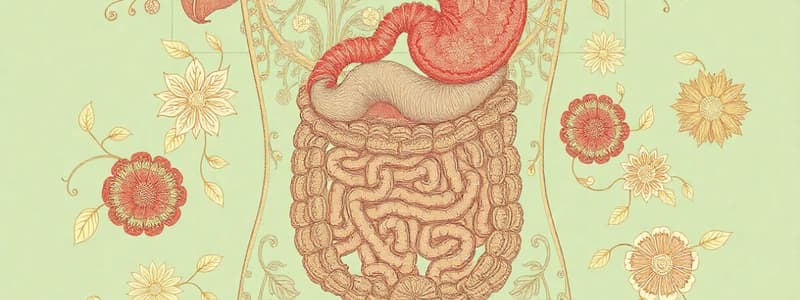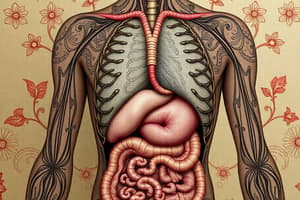Podcast
Questions and Answers
The respiratory system uses the chest and diaphragm muscles to move air in and out of the lungs.
The respiratory system uses the chest and diaphragm muscles to move air in and out of the lungs.
True (A)
Which of the following is NOT a component of the respiratory system?
Which of the following is NOT a component of the respiratory system?
- Bronchi
- Arteries (correct)
- Alveoli
- Trachea
The _______ are tiny, air-filled sacs at the ends of bronchioles where gas exchange occurs.
The _______ are tiny, air-filled sacs at the ends of bronchioles where gas exchange occurs.
alveoli
Match the following structures with their correct descriptions:
Match the following structures with their correct descriptions:
Which of the following is NOT a function of the central nervous system?
Which of the following is NOT a function of the central nervous system?
Reflexes are conscious responses to stimuli that involve the brain.
Reflexes are conscious responses to stimuli that involve the brain.
What type of neurons carry information from the central nervous system to muscles and organs?
What type of neurons carry information from the central nervous system to muscles and organs?
The ______ controls thinking, talking, and moving.
The ______ controls thinking, talking, and moving.
Which of the following is NOT a sensory receptor found in the skin?
Which of the following is NOT a sensory receptor found in the skin?
Match the brain region with its primary function:
Match the brain region with its primary function:
Why is the skin's sensitivity to touch not uniform across the body?
Why is the skin's sensitivity to touch not uniform across the body?
Interneurons are responsible for connecting sensory neurons to motor neurons in the reflex arc.
Interneurons are responsible for connecting sensory neurons to motor neurons in the reflex arc.
Which of the following is NOT a component of the digestive system?
Which of the following is NOT a component of the digestive system?
Mechanical digestion involves the use of enzymes to break down food particles.
Mechanical digestion involves the use of enzymes to break down food particles.
What is the role of the epiglottis in the digestive process?
What is the role of the epiglottis in the digestive process?
Saliva contains an enzyme called ______ that starts the breakdown of starch.
Saliva contains an enzyme called ______ that starts the breakdown of starch.
Match the following digestive system components with their primary functions:
Match the following digestive system components with their primary functions:
Which of the following is a type of energy that cells utilize?
Which of the following is a type of energy that cells utilize?
The digestive system is comprised of a single tube-like structure.
The digestive system is comprised of a single tube-like structure.
Describe the process of mechanical digestion.
Describe the process of mechanical digestion.
Which side of the heart pumps blood to the lungs?
Which side of the heart pumps blood to the lungs?
Veins carry blood away from the heart.
Veins carry blood away from the heart.
What is the primary function of the excretory system?
What is the primary function of the excretory system?
The ______ converts harmful ammonia into urea.
The ______ converts harmful ammonia into urea.
Match the following blood vessels with their descriptions:
Match the following blood vessels with their descriptions:
The esophagus uses wave-like movements called peristalsis to move food from the mouth to the stomach.
The esophagus uses wave-like movements called peristalsis to move food from the mouth to the stomach.
The ______ is responsible for churning food and mixing it with gastric juices.
The ______ is responsible for churning food and mixing it with gastric juices.
Which of the following is NOT a component of gastric juices?
Which of the following is NOT a component of gastric juices?
What is the role of bile in digestion?
What is the role of bile in digestion?
Match the following digestive organs with their primary function:
Match the following digestive organs with their primary function:
The large intestine absorbs water, vitamins, and minerals, but does not play a role in forming feces.
The large intestine absorbs water, vitamins, and minerals, but does not play a role in forming feces.
What is the main function of the respiratory system?
What is the main function of the respiratory system?
Explain why mountain climbing at high altitudes can be dangerous.
Explain why mountain climbing at high altitudes can be dangerous.
Which of the following is not a component of the excretory system?
Which of the following is not a component of the excretory system?
The renal arteries carry blood from the kidneys to the rest of the body.
The renal arteries carry blood from the kidneys to the rest of the body.
The ______ is a sac that stores urine before it is excreted.
The ______ is a sac that stores urine before it is excreted.
Which of the following molecules is not typically found in urine?
Which of the following molecules is not typically found in urine?
Match the following excretory system parts to their functions:
Match the following excretory system parts to their functions:
Flashcards
Cells
Cells
Basic building blocks of living organisms that perform functions necessary for life.
Tissues
Tissues
Groups of similar cells that work together to perform a specific function.
Organs
Organs
Structures made up of different tissues that perform specific tasks in the body.
Digestive System
Digestive System
Signup and view all the flashcards
Mechanical Digestion
Mechanical Digestion
Signup and view all the flashcards
Chemical Digestion
Chemical Digestion
Signup and view all the flashcards
Response to Stimuli
Response to Stimuli
Signup and view all the flashcards
Circulatory System
Circulatory System
Signup and view all the flashcards
Peristalsis
Peristalsis
Signup and view all the flashcards
Gastric Juices
Gastric Juices
Signup and view all the flashcards
Hydrochloric Acid
Hydrochloric Acid
Signup and view all the flashcards
Mucus in Stomach
Mucus in Stomach
Signup and view all the flashcards
Small Intestine
Small Intestine
Signup and view all the flashcards
Liver Function
Liver Function
Signup and view all the flashcards
Role of Pancreas
Role of Pancreas
Signup and view all the flashcards
Large Intestine
Large Intestine
Signup and view all the flashcards
Breathing
Breathing
Signup and view all the flashcards
Gas Exchange
Gas Exchange
Signup and view all the flashcards
Alveoli
Alveoli
Signup and view all the flashcards
Bronchi
Bronchi
Signup and view all the flashcards
Bronchioles
Bronchioles
Signup and view all the flashcards
Capillaries
Capillaries
Signup and view all the flashcards
Heart
Heart
Signup and view all the flashcards
Renal arteries
Renal arteries
Signup and view all the flashcards
Ureters
Ureters
Signup and view all the flashcards
Bladder
Bladder
Signup and view all the flashcards
Excretory system function
Excretory system function
Signup and view all the flashcards
Neurons
Neurons
Signup and view all the flashcards
Dendrites
Dendrites
Signup and view all the flashcards
Central nervous system
Central nervous system
Signup and view all the flashcards
Peripheral nervous system
Peripheral nervous system
Signup and view all the flashcards
Sensory Neurons
Sensory Neurons
Signup and view all the flashcards
Motor Neurons
Motor Neurons
Signup and view all the flashcards
Cerebrum
Cerebrum
Signup and view all the flashcards
Reflex
Reflex
Signup and view all the flashcards
Interneurons
Interneurons
Signup and view all the flashcards
Receptors in Skin
Receptors in Skin
Signup and view all the flashcards
Sensitivity of Skin
Sensitivity of Skin
Signup and view all the flashcards
Right side of the heart
Right side of the heart
Signup and view all the flashcards
Left side of the heart
Left side of the heart
Signup and view all the flashcards
Arteries
Arteries
Signup and view all the flashcards
Veins
Veins
Signup and view all the flashcards
Excretory system
Excretory system
Signup and view all the flashcards
Kidneys
Kidneys
Signup and view all the flashcards
Liver
Liver
Signup and view all the flashcards
Study Notes
Human Function and Interacting Systems
- Healthy human function relies on interacting systems.
- Organ systems depend on each other for optimal function.
Key Concepts
- Cells
- Organs
- Tissues
- Structure and function
- Response to stimuli
- Systems
Learning Outcomes
- Describe how body systems work.
- Recognize roles of organs/tissues in body systems.
- Explain how cells help the body function.
- Show how the body responds to changing conditions.
Digestive System
- Living organisms need energy from carbohydrates, lipids, and proteins.
- The digestive system breaks down food into smaller, usable particles.
- Mechanical digestion breaks food into smaller pieces.
- Chemical digestion uses enzymes to further break down large molecules.
- Digestion takes place in different parts of the digestive system.
The Mouth and Esophagus
- Digestion begins in the mouth.
- Teeth mechanically break down food.
- Saliva moistens food and contains enzymes (salivary amylase) that breaks down starch.
- Epiglottis prevents food from entering the trachea.
- Food travels through the esophagus by peristalsis (wave-like muscle contractions).
The Stomach
- The stomach churns food.
- Gastric juice (mucus, hydrochloric acid, water, and digestive enzymes) mixes with food.
- Hydrochloric acid chemically digests proteins.
- Mucus protects the stomach lining from digestion.
- Food is slowly released into the small intestine as a liquid.
The Small Intestine, Pancreas, Liver, and Gallbladder
- Chemical digestion continues in the small intestine.
- Pancreas releases digestive enzymes.
- Liver produces bile, stored in the gallbladder.
- Bile breaks down fats.
- Small intestine absorbs nutrients.
- Villi and microvilli increase surface area for absorption.
- Nutrients are absorbed into the bloodstream.
The Large Intestine
- Water and vitamins are absorbed.
- Undigested material forms feces.
- Feces are expelled through the rectum.
Respiratory System
- The respiratory system supplies oxygen to the blood and removes carbon dioxide.
- Breathing involves inhaling and exhaling air.
- The process of exchanging gases takes place in the alveoli.
- Alveoli are tiny air sacs in the lungs, surrounded by capillaries.
- Oxygen diffuses into the blood, and carbon dioxide diffuses out.
Circulatory System
- The circulatory system transports nutrients and oxygen.
- It removes waste products.
- The heart pumps blood through arteries, veins, and capillaries.
- Arteries carry blood away from the heart.
- Veins carry blood to the heart.
- Capillaries exchange substances with tissues.
The Heart
- The heart acts as a pump with two sides.
- The right side pumps blood to the lungs.
- The left side pumps oxygenated blood to the body.
- The heart has four chambers (two atria and two ventricles).
Arteries, Veins, and Capillaries
- Arteries have thicker walls than veins to withstand the pressure of the pumping heart.
- Veins have valves to prevent backflow.
- Capillaries are thin-walled to facilitate diffusion.
Excretory System
- The excretory system removes waste products like urea and excess water.
- Kidneys filter urea and wastes from blood creating urine.
- Urine travels to the bladder for storage.
- Urine is expelled from the body.
- Other parts like skin and lungs also remove waste.
Nervous System
- The nervous system receives stimuli and sends messages to react.
- Sensory nerves detect changes (stimuli).
- Motor neurons (message carriers) trigger responses.
- The brain and spinal cord form the central nervous system.
- Nerves make up the peripheral system.
Studying That Suits You
Use AI to generate personalized quizzes and flashcards to suit your learning preferences.




